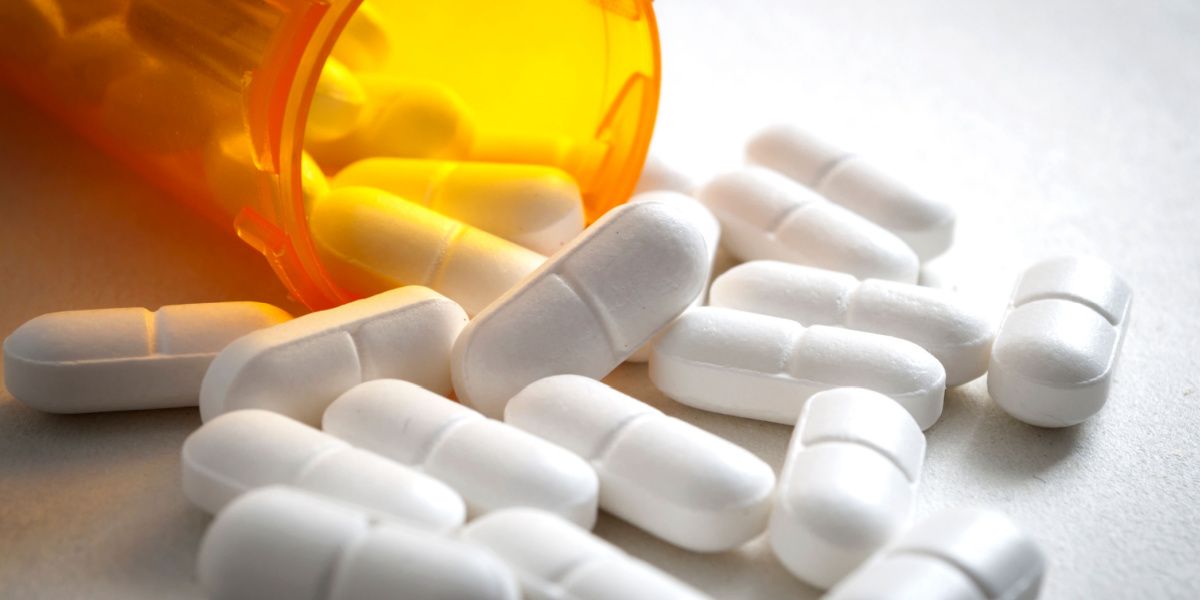Oxycodone is an opioid analgesic that is widely used and misused. Oxycodone often causes side effects, including drowsiness, dizziness, nausea, reduced appetite, and constipation. Severe side effects, dependence, and overdose can occur, particularly if it is abused or used for prolonged periods.
- Oxycodone commonly causes side effects like nausea, dizziness, and constipation.
- Prolonged or high doses of oxycodone can lead to severe side effects, including respiratory depression and overdose.
- Misuse of oxycodone increases the risks of dependence, addiction, and severe complications.

What is oxycodone?
Oxycodone is a semi-synthetic opioid or narcotic analgesic medication. It is a Schedule II controlled substance due to its potential for abuse and dependence. [1]
Oxycodone is a widely prescribed painkiller in the United States. It is commonly associated with the opioid epidemic, leading to increases in addiction, abuse, and overdose of prescription opioids. [2][3]
What is oxycodone used for?
Oxycodone is available both as an immediate-release formulation, which is approved for acute and chronic, moderate to severe pain conditions, and as an extended-release formulation, which is only approved for long-lasting and severe pain that requires round-the-clock treatment. Oxycodone should only be used when other pain relief is ineffective and should not be prescribed as a PRN (as-needed) treatment. [1][4]
Oxycodone can only be obtained with a prescription and can be taken as a combination product or oxycodone-only product. Available brand-name medications containing oxycodone include: [5]
- OxyContin (oxycodone) extended-release
- Oxaydo (oxycodone) immediate-release
- Oxycet (acetaminophen and oxycodone)
- Percocet (acetaminophen and oxycodone)
- Percodan (aspirin and oxycodone)
Immediate-release medications can be taken every four to six hours, while extended-release formulations should be taken every 12 hours. [5]
Why do people abuse oxycodone?
Oxycodone causes sedating, euphoric, and analgesic effects, causing a ‘high’, which contributes to its abuse potential. People who abuse oxycodone may have been prescribed the medication or purchased it illicitly. When it is abused, it is often administered by crushing and nasally inhaling (snorting) or dissolving and injecting, to create an enhanced effect. [6]
Oxycodone is a widely prescribed medication, increasing the potential for its abuse and making it easily accessible to those who abuse it. Many people begin abusing oxycodone that has been prescribed to them, following the development of tolerance or dependence. This can result in the use of increased or more frequent doses. [1][3]
Depending on an individual’s circumstances, a doctor may change dosages, permitting their patients to take increasing amounts of oxycodone. If the prescribing doctor does not increase the dosage, this may lead to illicit purchasing of the medication when individuals require higher doses to prevent withdrawal symptoms. [4][6]
People have been found to use forged or counterfeit prescriptions to get additional tablets or attempt to obtain numerous prescriptions from several doctors, known as ‘doctor shopping’. These tablets are then sold or shared illicitly or kept for personal use. [1]
Common side effects of oxycodone
Oxycodone is likely to cause side effects when taken as prescribed or illicitly. Common side effects of oxycodone include: [1][4][5]
- Drowsiness
- Dizziness
- Nausea
- Vomiting
- Diarrhea
- Constipation
- Stomach pain
- Weakness
- Fatigue
- Dry mouth
- Sweating
- Itchy skin
- Heart palpitations
- Changes in blood pressure or heart rate
- Reduced appetite
- Irritability
- Confusion
- Urinary retention
Severe side effects of oxycodone
In some cases, oxycodone can cause severe side effects, particularly if it is abused or taken for prolonged periods. Severe side effects of oxycodone include: [1][4][5]
- Seizures
- Psychotic symptoms, such as hallucinations or paranoia
- Trouble breathing or swallowing
- Slowed or stopped breathing
- Severe reduction in blood pressure
- Persistent vomiting or diarrhea
- Extreme changes in mood and behavior, including aggression or suicidal thoughts and attempts
- Chest pain and tightness
- Swelling of the mouth and throat
- Extreme drowsiness and oversedation
Prolonged use or abuse of oxycodone can increase the risk of severe side effects, tolerance, dependence, and addiction.
Tolerance develops with extended use and causes the effects of the medication to become reduced, resulting in the need for increased or more frequent doses. [6]
Dependence becomes more likely with heavy and prolonged use, although it can develop within weeks of prescribed use. Dependence causes the individual to become reliant on the effects of the medication, with withdrawal symptoms occurring if it is discontinued. Common oxycodone withdrawal symptoms include sweating, weakness, flu-like symptoms, insomnia, mood changes, pain, and diarrhea. [1]
Addiction is a physical and psychological condition that differs from dependence and tolerance, although it often occurs alongside their development. It can cause compulsive and dangerous drug-seeking and taking behaviors, regardless of detrimental effects on well-being and quality of life. [1][2]
Oxycodone overdose
Oxycodone use can result in an overdose. This risk is higher if it is abused or used in heavy doses but can also occur when used exactly as prescribed. [4]
Oxycodone has depressant effects on the central nervous system (CNS), which impacts the cardiac and respiratory systems. If oxycodone is used in combination with other CNS depressants, such as alcohol or benzodiazepines, the risk of overdose is significantly increased and can result in dangerous or fatal effects such as respiratory depression and coma. [1]
Abusing oxycodone can also increase the risk of overdose. For example, if extended-release tablets are crushed and nasally inhaled or injected, the medication is released more rapidly into the body than intended, which may result in an overdose. [1][6]
Taking illicitly purchased oxycodone tablets can lead to overdose as the contents are not always known. For example, some dealers use fentanyl to make counterfeit oxycodone tablets, as it is a cheaper and more potent substance. If an individual consumes one of these pills, they are more likely to overdose, as fentanyl is up to 100 times more potent than other opioids and small doses can potentially be lethal. [7]
Signs of an oxycodone overdose include: [1][5]
- Reduced heart rate
- Cold, clammy skin
- Pinpoint pupils
- Extreme weakness
- Trouble breathing
- Stopped breathing
- Loss of consciousness
- Unresponsiveness
In the event of an overdose, call 911 immediately. Life-saving treatment may be required, including the administration of naloxone, which can reverse or block the effects of oxycodone. Some people who are prescribed oxycodone may be given doses of naloxone to keep at home in case of an emergency. [5]
Getting treatment for oxycodone dependence
Individuals who are dependent on oxycodone, whether prescribed or illicit, may wish to seek professional advice and treatment. Reducing or stopping oxycodone can result in withdrawal symptoms, so this should be done alongside professional support and intervention. [8]
Treatment can be provided through outpatient programs, such as a clinic, or inpatient programs, such as a rehab center. Professionals can monitor the individual and treat withdrawal symptoms. During and following detox, treatments and interventions can be implemented, such as medications, group and individual therapies, holistic therapies, and physical health treatment. [2][9]
Medications are often prescribed to treat oxycodone dependence and can help manage withdrawal symptoms, prevent relapse, maintain abstinence, and improve overall functioning and quality of life. This includes: [2][8][9]
- Methadone and buprenorphine: Methadone and buprenorphine are opioid agonists, which means that they have a similar effect on the brain to oxycodone, although they do not produce the same level of euphoric effects. They can be used as replacement opioids, helping prevent cravings and withdrawal symptoms, and can be used as a long-term maintenance treatment.
- Naltrexone: Naltrexone can be used following oxycodone withdrawal and can help to prevent relapse by blocking the euphoric effects of oxycodone, deterring its use. It should be commenced at least 7-10 days following the last dose of oxycodone or other opioids and can be used as a long-term maintenance treatment.
- Clonidine, benzodiazepines, and non-opioid pain relief: Used as short-term treatments during detox to help reduce withdrawal symptoms such as anxiety, insomnia, nausea, vomiting, diarrhea, and pain.
Often, individuals require long-term treatment for oxycodone dependence, to maintain abstinence and improve the recovery process. This includes psychosocial interventions, support groups such as Narcotics Anonymous or 12-step programs, maintenance medications, and psychotherapy support for any underlying physical and mental health conditions. [2][8]



-guide-detail.jpg?v=1756808574)
-guide-detail.jpg?v=1756808603)